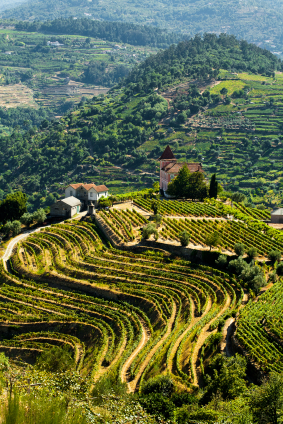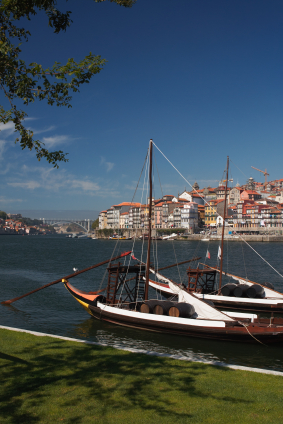The Portuguese Wine Scene

Portuguese wines have a long heritage and tradition, particularly in Britain with Port making a big influence in the fortified wine category, but their still wines have faced more difficulty to market, lacking real public knowledge about grapes and regions. Grape growing represents about 35% of Portugal's agricultural output and they are about the 10th largest exporter of wine by volume. In recent decades, their still unfortified have witnessed steady growth with the promotional body 'Wines of Portugal' helping promote the country interntionally. Their wines represent very good value for money generally, consistently punching above their weight in wine competitions, winning more golds proportionately than almost any other country.
Still, there is more work to do in getting these excellent wines out there in public knowledge. Part of the problem lies in the fact that generally the majority of the labels are difficult to read, and recognise. There is also relatively little understanding of the styles of wines, and few recognisable regional household names like Rioja in Spain as a point of comparison.
That has begun to change in recent years however, with the rise of the light, zippy white wine of the north, Vinho Verde, Portuguese Rose, made famous in the 1970s by Mateus Rose and big brands like Porta 6 sweeping the market. It broke Majestic Wine's website when it first launched such was the demand for it! Tagus Creek was probably the first big Portuguese wine to make real inroads, with a range of white, rose and red wines, a modern label and pronounceable name created by an Englishman. This brand has all but disappeared from supermarket shelves but it paved the way for the recognisable Portuguese wines we now see.
The Country And Its Wine History

Portugal has a long history and tradition of winemaking, and also a long association with England. Historians believe wine was made in the Tagus and Sado valleys as far back as 2000 BCE, introduced by the Tartessians, and increased further by the Phoenicians who brought more vines, then the Greeks, then the Romans. The strong ties with England began with the historic Treaty of Windsor, signed in 1386, and the Methuen Treaty of 1703, which was a commercial and political agreement reached, as a result of the Spanish War of Succession. In essence, there was a beneficial tax system to both countries, which allowed Portugal to sell their wines to England, and for England to export its textiles.
The industry struggled throughout the 19th and much of the 20th centuries with the Peninsular Wars and the Portuguese Civil War coming just as Spanish and French wines began to gain appeal across Europe, cutting Portugal out of the race rather. Phylloxera then hit Europe in the late 1800s further devastating Portuguese as well as most of European vines. Next, the 40
year rule of prime minister Antonio de Oliviera Salazar from 1932 resulted in the promotion of poor quality wine made by ill-equipped, badly run co-operatives, the reputation of which Portugal still suffers from. With the Carnation Revolution and a return to democracy in the mid-1970s followed by Portugal’s accession to the EU, things began to look up!
Portugal produces a wide variety of wine styles, and has stayed very true to its indigenous routes, with a relatively low proportion of wines being produced from international varieties such as Chardonnay and Cabernet Sauvignon. This in itself may be one of the reasons why Portugal struggles to establish itself, especially for its reds, in the international market, because both the regional and varietal labelling on the bottles are difficult to understand and are not easily recognisable.
The most famous wine region in Portugal is the Douro, an area of incredible beauty, and breathtaking scenery in the northern part of the country, and the home of Port. Whilst most people think of the Douro as the place where Port is made, there is now a high proportion of top quality table wines, being made on these steep, remote slopes.
The climate and terrain differ widely from north to south, with the strong influence of the Atlantic prevalent throughout. Rainfall is generally high, although less so in the south, and more southern coastal regions have to be watchful about this natural irrigation to ensure that yields do not go too high, and impact on quality – Terrains and terroirs differ widely, from the steep slopes of the Douro, and the lush, verdant vineyards of the Minho in the north, to the sandy coastal plains of central Portugal, and the wide, flat plains of the Tejo and the Alentejo east and south of Lisbon.
Until the late 80s, it was the northern vineyards of Portugal, which were best known, with Dao and Bairrada, probably the best known of the red wines. Today, the emphasis has shifted to the south, to the vast plains of the Tejo and the Alentejo, where new styles are evolving, and where a host of international winemakers began making new styles of wine in the 80s; the centre and south of Portugal is now where much of the emphasis is.
Portugese Wine Regions
The wine regions of Portugal cover the majority of the country, and encompass numerous different soil types, topography, and climates, from the wet, cold, continental Minho, on the Atlantic, at the north of the country, to the sun-baked plains of the inland Alentejo and Estremadura in the central-south, and indeed as far south as Sir Cliff Richard’s estate in the Algarve!
The wide variety of wine styles, naturally fit to the weather patterns and overall climate, with the north producing, light, fresh, lower alcohol styles, mainly white, with reds dominating the south, although there is no general rule, with some fragrant, stylish whites now coming from the cooler climate regions of the central south of the country.
Discover Portuguese wine regions and click on them to find out more and see their wines below:
Grapes, Wine Styles And Food Matching
Portugal’s vineyards comprise a mix of indigenous and international grape varieties, and the majority of the wines are labelled by region, in the case of the northern half of the country and by grape variety in the south.
Here are some key style pointers:
Vinho Rosado
The famous pink wine, in the short, stubby bottle has been made famous by Mateus rose. Now supermarkets all have their own brand version. The wine is made from a variety of grapes, much of it from the Baga grape, and is generally soft, medium dry, or medium sweet, with a fruity, bubble gum character, and a lively spritz.
What does it go with?
Drink chilled on their own, with a bowl of strawberries, or will just about cope with something like Coronation chicken, or a mild Korma.
Baga - Bairrada
The Baga grape is a small dark grape, with thick skin, which produces big, tannic wines. It needs careful handling, and at its best, produces full bodied, powerful, inky reds, but at worst, harsh, tannic reds. It is also one of the main grape varieties used in the production of the thousands of gallons of Portuguese rose that is produced.
What does it go with?
This is definitely a food wine, and needs a hefty, well cooked stew, or braised lamb to match the power of the grape and the wine.
Fernao Pires - Bairrada and Tejo
This aromatic white grape, is indigenous to Portugal, and is one of a few white grapes which is not suited to cool climates, which makes it ideal for Portugal’s hot weather. Grown in Bairrada and Estremadura, it has a floral, tangerine and citrus aroma, and a soft, creamy, honeysuckle and lemon character. It is produced in both oaked and unoaked styles.
What does it go with?
The aromatic, creamy style of this grape, makes it a great match for richer fish dishes, such as salmon, chicken in a creamy sauce, pork with apples and herbs, and fruity, north African and Lebanese dishes.
Arinto - Tejo/Alentejo/Bairrada
Arinto is another Portuguese white grape variety, that has a high acid level, and is thus able to cope far more easily, with the hot, dry climate, of the region of Estremadura, where it is primarily grown, whereas more delicate white grapes, would crumble under the heat, and turn out flabby, alcoholic, characterless rubbish!
It has quite a unique, elegant style, especially when well made in its natural home, the area of Bucelas, in the Estremadura region. It is highly aromatic, with wafting scents of ripe white peaches, nectarines and pink grapefruit, with a similar spectrum on the palate, and yet, with a delightfully zesty, lime fresh edge on the finish of many of the wines.
What does it go with?
The food matches are similar to those for the similarly aromatic Fernao Pires – fish, chicken and pork in fruity sauces, sweetly spiced North African and Middle Eastern tagines, salmon with creamy, tarragon-infused hollandaise, and grilled white fish and sardines with lemon, orange and herbs.
Castelão - Península de Setúbal/Tejo/Alentejo
This is the main grape grown in the south of Portugal, and is the star of the Alentejo region, where is produces, rich, spicy, dried fruit infused wines. It is known in the rest of the country as the Castelao, or the Trincadeira Preta. It produces dense, rich, yet soft wines, which are far less tannic than their northern counterparts, and is the most widely planted red grape in Tejo, Alentejo and Península de Setúbal. Soft, velvety, with rich black fruit and chocolate spice, these are stylish, attractive wines and some of the most approachable and early drinking of Portuguese reds.
What does it go with?
These wines are superb food wines, and will happily partner roast lamb, barbecued meats, game, including pheasant. They are great with winter stews, steak pies, and rich braised dishes, as well as mature cheeses, and would also cope with mild Indian curries, due to their natural sweet spiciness.
Portugal also produces a host of other grape varieties, including many of the international wines – mainly Chardonnay, some Sauvignon Blanc, Cabernet Sauvignon, Merlot and some Syrah.